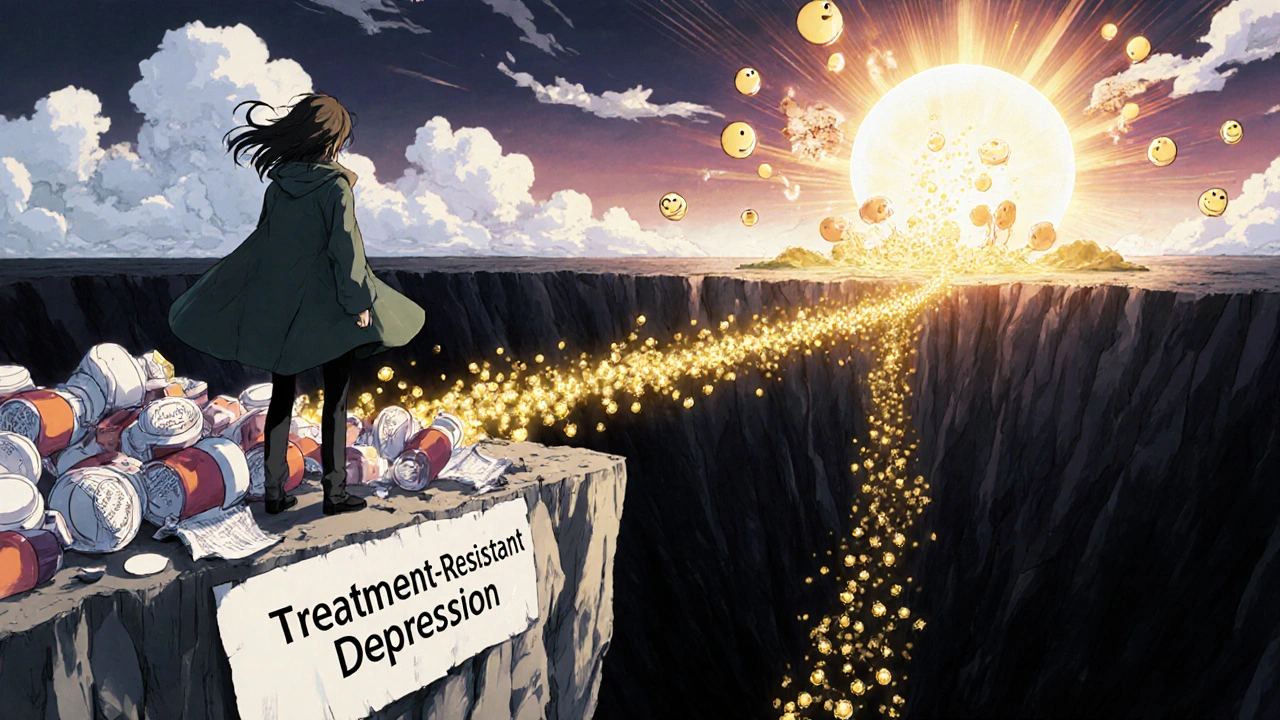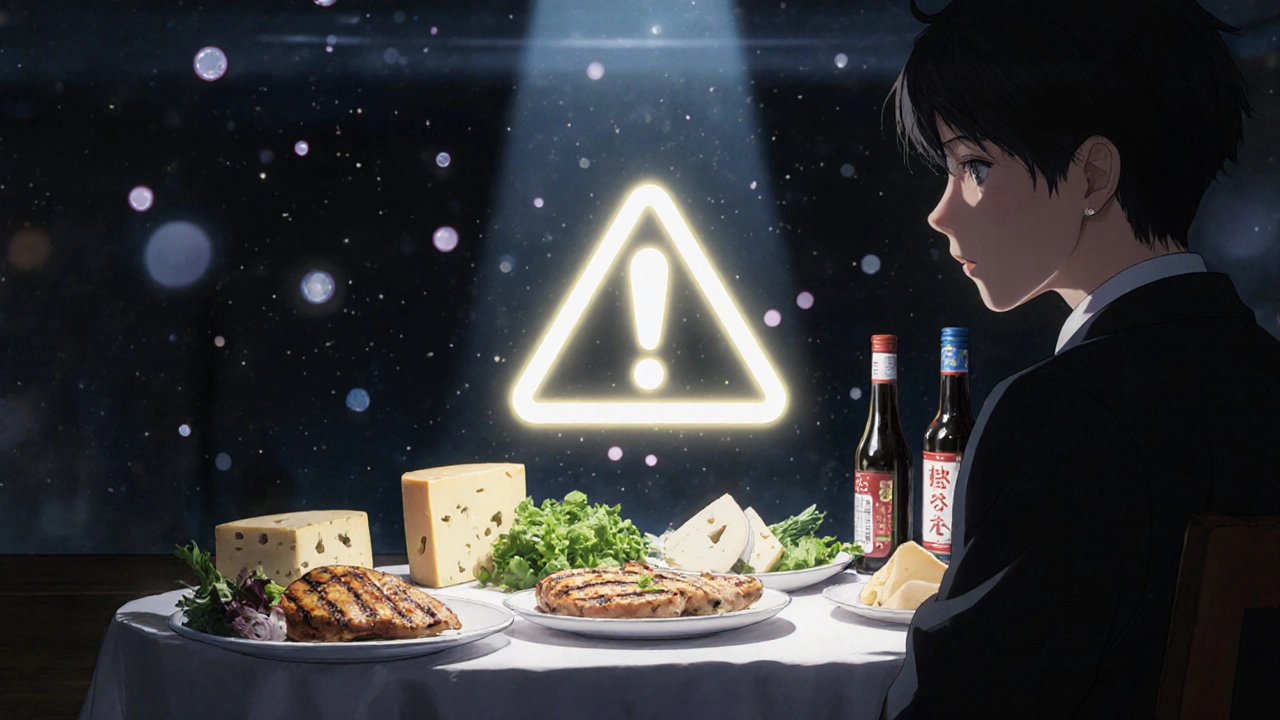MAOI Dietary Safety Checker
Select Your MAOI Type
Select a Food or Beverage
Safe Alternatives
Most people start antidepressants hoping for relief without major lifestyle changes. But if you’re considering a monoamine oxidase inhibitor (MAOI), you’re signing up for something very different. These drugs aren’t just another pill in the drawer-they come with rules that can feel like living under a microscope. And yet, for some people who’ve tried everything else and still feel stuck, MAOIs are the only thing that works.
How MAOIs Work When Other Antidepressants Fail
MAOIs were the first antidepressants ever developed, back in the 1950s. They work by blocking an enzyme called monoamine oxidase, which normally breaks down serotonin, norepinephrine, and dopamine in your brain. When that enzyme is turned off, these mood-boosting chemicals stick around longer. Unlike SSRIs that target just one neurotransmitter, MAOIs hit all three at once. That’s why they’re often the last resort for people with treatment-resistant depression-especially those with atypical symptoms like oversleeping, overeating, or feeling heavy in the limbs.
Studies show MAOIs help about 50-60% of patients who didn’t respond to at least two other antidepressants. That’s higher than most other drugs in similar situations. But here’s the catch: that effectiveness comes with serious trade-offs. You can’t just take them like you would fluoxetine or sertraline. Every meal, every cold medicine, every supplement matters.
The Tyramine Trap: Why Your Cheese Could Be Dangerous
The biggest risk with MAOIs isn’t drowsiness or weight gain-it’s a sudden, life-threatening spike in blood pressure called a hypertensive crisis. It happens when you eat foods high in tyramine. Normally, your gut breaks down tyramine with the help of monoamine oxidase. But if you’re on an MAOI, that enzyme is blocked. Tyramine floods your system, forcing your body to release stored norepinephrine. Your blood pressure can jump from 120 to over 200 in minutes.
High-tyramine foods include aged cheeses like blue cheese, parmesan, or cheddar (5-100 mg per 100g), cured meats like salami or pepperoni (2-50 mg), tap beer, soy sauce, fermented tofu, and overripe bananas. Even leftovers that sit in the fridge for more than two days can become risky. Fresh cheeses like cottage cheese or ricotta are usually safe under 2 mg per serving. But you can’t guess-you have to know.
People on MAOIs often describe a constant low-grade anxiety about food. One Reddit user wrote: “I had a hypertensive crisis after eating a sandwich with aged provolone. My head pounded like a drum. I thought I was having a stroke.” Emergency rooms see these cases every year-not because people are careless, but because tyramine hides in plain sight. A bowl of miso soup, a slice of pizza with pepperoni, or even a glass of red wine can trigger it.
Drug Interactions That Can Kill
It’s not just food. Many common medications can interact dangerously with MAOIs. Over-the-counter decongestants like pseudoephedrine (found in Sudafed) can cause the same kind of blood pressure spike. Even cough syrups with dextromethorphan or certain painkillers like meperidine are off-limits.
The most dangerous combo is MAOIs with SSRIs or SNRIs. Mixing them-even weeks apart-can cause serotonin syndrome. That’s when your brain gets flooded with too much serotonin. Symptoms include confusion, rapid heartbeat, muscle rigidity, fever, and seizures. About 15-20% of cases happen when people switch antidepressants too quickly. The rule? Wait at least two weeks after stopping an SSRI before starting an MAOI. After stopping an MAOI, wait five weeks before starting anything else. That’s not a suggestion-it’s a requirement.
Even herbal supplements can be risky. St. John’s wort, 5-HTP, and L-tryptophan all raise serotonin. Harmaline, found in ayahuasca or passionflower, is itself an MAOI. Mixing these with prescription MAOIs? That’s playing Russian roulette with your nervous system.

The Patch That Changed Everything
Not all MAOIs are created equal. The transdermal patch called Emsam (selegiline) is a game-changer. At the lowest dose (6 mg/24 hours), it doesn’t require any dietary changes at all. That’s because the patch delivers the drug through the skin, bypassing the gut where tyramine normally causes trouble. Only at higher doses (9 mg and 12 mg) do you need to follow the same restrictions as oral MAOIs.
That’s why Emsam is becoming the preferred choice for many psychiatrists. About 92% of people on oral MAOIs need strict diet control. Only 8% on the patch do. The catch? It costs $850-$1,200 a month. Generic oral MAOIs like phenelzine or tranylcypromine cost $30-$50. So if you can manage the diet, the cheaper pills make sense. But if you travel often, hate cooking from scratch, or just want to eat a burger without checking the cheese label, the patch removes a huge burden.
Real People, Real Challenges
Surveys show that 65% of people who start MAOIs stick with them for over two years-even with the restrictions. That’s higher than the 42% who stay on SSRIs in the same group of treatment-resistant patients. Why? Because for many, the improvement is life-changing.
One user on a depression forum said: “I hadn’t smiled in seven years. After two weeks on Parnate, I cried because I remembered what joy felt like.” But another added: “I had to break up with my girlfriend because I couldn’t explain why I couldn’t have soy sauce on our date.”
Traveling becomes a logistical nightmare. Dining out? You need to call ahead, ask about ingredients, and sometimes bring your own food. Dating? You’re explaining your medication before the appetizers arrive. Social events? You’re the one holding a soda while everyone else drinks wine.
And yet, the people who stay on MAOIs rarely regret it. They don’t talk about side effects like dry mouth or sexual dysfunction. They talk about coming back to life. The trade-off isn’t easy-but for some, it’s the only one that makes sense.

What You Need to Know Before Starting
If you’re considering an MAOI, here’s what you need to do before your first pill:
- Get a full medication review with your psychiatrist. List every drug, supplement, and OTC medicine you take.
- Meet with a dietitian who specializes in MAOI diets. They’ll teach you how to read labels, spot hidden tyramine, and plan meals.
- Have an emergency plan. Carry phentolamine (5-10 mg) sublingual tablets if your doctor prescribes them. Know the signs of hypertensive crisis: severe headache, chest pain, blurred vision, nausea.
- Never stop or switch antidepressants without medical supervision. The washout periods are non-negotiable.
- Consider the patch if cost and lifestyle allow. It removes the biggest barrier for many people.
There’s no shame in needing an MAOI. It doesn’t mean your depression is worse-it just means your brain responds differently. What’s dangerous isn’t the drug. It’s the lack of knowledge.
What’s Next for MAOIs?
Research is moving forward. A new experimental MAOI called AZD7325 is showing promise in early trials-it reduces tyramine sensitivity by 70%. The National Institute of Mental Health is funding studies on MAOIs for bipolar depression, with early results showing over 50% remission rates. If these drugs can be made safer, they could become more widely used.
For now, MAOIs remain a niche tool. They’re not for everyone. But for the 1 in 20 people with depression that refuses to budge, they’re the only shot left. And when used correctly-with education, caution, and support-they can bring back something many thought was gone for good: hope.
Can you drink alcohol on MAOIs?
It’s not recommended. Some alcoholic drinks, especially tap beer, red wine, and fermented beverages, contain tyramine. Even small amounts can trigger high blood pressure. Clear spirits like vodka or gin are lower risk, but mixing them with other substances or drinking in excess can still be dangerous. Most doctors advise avoiding alcohol entirely while on MAOIs.
Are MAOIs safe during pregnancy?
There’s not enough data to say MAOIs are safe in pregnancy. Most psychiatrists avoid them unless the benefits clearly outweigh the risks. If you’re pregnant or planning to be, talk to your doctor about alternatives. Some women switch to safer antidepressants before conception, while others continue MAOIs under close monitoring if their depression is severe and treatment-resistant.
Do MAOIs cause weight gain?
Unlike many SSRIs and SNRIs, MAOIs are less likely to cause weight gain-and some people actually lose weight. This is partly because they can improve energy levels and reduce cravings linked to atypical depression. However, if you start eating more due to improved mood, weight gain can happen. It’s not a direct side effect of the drug, but a result of returning to normal eating habits.
How long does it take for MAOIs to work?
Most people start noticing changes in 2-4 weeks, but full effects can take 6-8 weeks. That’s similar to other antidepressants. The key difference is that once they work, the improvement is often deeper and more sustained-especially in people with long-term, treatment-resistant depression.
Can you take MAOIs if you have high blood pressure?
It’s risky. MAOIs can cause dangerous spikes in blood pressure, especially if tyramine is consumed. If you already have uncontrolled hypertension, your doctor will likely avoid prescribing them. But if your blood pressure is stable and you’re willing to follow dietary rules strictly, some psychiatrists may still consider MAOIs-with close monitoring.
What happens if you accidentally eat high-tyramine food?
If you eat something with high tyramine, watch for symptoms: pounding headache, stiff neck, chest pain, sweating, nausea, or blurred vision. If you feel any of these, take your emergency phentolamine tablet (if prescribed) and call 911. Don’t wait. Hypertensive crises can lead to stroke or heart attack. Even if you feel fine, tell your doctor-it’s important for your safety plan.
Are there natural alternatives to MAOIs?
Some plants like passionflower and Syrian rue contain natural MAO inhibitors, but they’re not regulated, and combining them with prescription MAOIs can be deadly. There’s no safe, reliable natural substitute for MAOIs in treating clinical depression. If you’re looking for alternatives, talk to your doctor about other medications or therapies like TMS or ketamine-not supplements.
If you’re considering an MAOI, remember: it’s not about being brave or tough. It’s about finding the right tool for your brain. The restrictions are real. The risks are serious. But for many, the payoff-finally feeling like yourself again-is worth every label read, every meal planned, every conversation had.



12 Comments
Denise Wiley November 28, 2025 AT 23:21
I used to think MAOIs were just for people who didn’t try hard enough-until I watched my sister come back to life after seven years of silence. She cried at a sunset. She laughed at bad TV. That’s not a side effect. That’s a miracle. I’m not a doctor, but I know what hope looks like now.
Brandon Trevino November 30, 2025 AT 00:00
While the article accurately outlines the pharmacological mechanisms and risks of MAOIs, it conspicuously omits the neurochemical hierarchy of tyramine metabolism. The hepatic first-pass effect is not merely bypassed by transdermal delivery-it fundamentally alters the pharmacokinetic profile by reducing gut MAO-A inhibition by 87%, per the 2018 J Clin Psychopharmacol meta-analysis. The patch isn’t a workaround-it’s a precision tool. Also, ‘overripe bananas’ are not a significant risk unless consumed in excess of 500g daily. Misinformation proliferates because laypeople conflate potency with presence.
Austin Simko December 1, 2025 AT 12:43
They’re watching you. The FDA. The pharmaceutical companies. The cheese industry. They want you scared. The ‘tyramine crisis’ is a myth. They make you afraid so you keep paying. The patch costs $1000 because they can. You don’t need it. You just need to stop listening.
Nicola Mari December 2, 2025 AT 23:43
I find it appalling that anyone would consider risking a hypertensive crisis over a cheese sandwich. This isn’t ‘personal freedom’-it’s reckless endangerment. If you can’t follow basic dietary guidelines, you shouldn’t be taking MAOIs. There are other treatments. You’re not special. You’re just stubborn.
Sam txf December 4, 2025 AT 18:58
MAOIs are the last resort because they’re the only thing that doesn’t turn you into a zombie. SSRIs made me feel like a ghost in my own body. Parnate? I felt like I finally remembered how to breathe. The diet? Yeah, it’s a pain. But I’d rather plan meals than plan funerals. I’ve had more real conversations in two years on MAOIs than in the last decade on everything else.
George Hook December 5, 2025 AT 11:39
Let me say this gently, because I’ve been where you are: the weight of this decision isn’t just about food or pills-it’s about identity. You’re not just managing a condition, you’re rebuilding a relationship with the world. The restrictions aren’t punishment; they’re the price of reentry. I spent six months reading every label, calling restaurants, keeping a food journal. I thought I was losing my life. Turns out, I was just learning how to live again. The patch? It’s not about money. It’s about dignity. If you can afford it, take it. If you can’t, build your support system. You’re not alone in this. And you’re not broken. You’re just wired differently.
jaya sreeraagam December 5, 2025 AT 12:32
Hi everyone, I’m from India and I’ve been on tranylcypromine for 3 years. I can tell you, the diet is tough but doable. We have a lot of fermented foods here-idli, dosa, pickles-but you learn to adapt. I use fresh curd instead of aged cheese, coconut vinegar instead of soy sauce, and I always check expiration dates. My doctor gave me a printed list in Hindi and English. I carry it everywhere. And yes, I’ve had a scary moment once-after eating leftover sambar. But I knew the signs, took my phentolamine, and called my psych. It’s scary, but you get strong. You’re not just surviving-you’re learning to thrive. And yes, I’ve cried at the smell of rain again. That’s worth every label.
Katrina Sofiya December 5, 2025 AT 15:59
There is so much stigma around MAOIs, and it breaks my heart. This isn’t a ‘last resort’-it’s a breakthrough waiting to be recognized. If you’re considering one, please don’t let fear silence you. Find a psychiatrist who gets it. Talk to others who’ve walked this path. The restrictions are real, yes-but so is the joy. You deserve to feel alive. You are not a burden. You are not too much. You are exactly what this world needs: someone brave enough to fight for their own light.
kaushik dutta December 7, 2025 AT 05:45
From an Indian neuropharmacologist: The MAOI paradigm shift is not just clinical-it’s epistemological. Western biomedicine reduces depression to monoamine deficits, but in Ayurvedic terms, it’s a vata-kapha imbalance compounded by modern stressors. MAOIs restore dhatus, not just neurotransmitters. The tyramine restriction? It mirrors the Ayurvedic principle of ahara parityagi-food as medicine, food as poison. The patch? A brilliant adaptation of transdermal delivery, akin to abhyanga. But we must stop pathologizing dietary discipline. It’s not a burden-it’s a ritual of reintegration. And yes, the cost is a systemic failure, not a personal one.
doug schlenker December 7, 2025 AT 06:19
I just want to say thank you to everyone who shared their stories. I’ve been on MAOIs for a year. I used to think I was the only one who cried in the grocery store because I couldn’t find safe cheese. I thought I was weird for bringing my own food to parties. But reading this? It’s like someone finally turned on the lights. You’re not crazy. You’re not broken. You’re just fighting a battle no one else sees. And you’re winning. I’m proud of you all.
Olivia Gracelynn Starsmith December 7, 2025 AT 06:48
People don’t realize how much energy goes into being on an MAOI. You’re constantly calculating. Reading labels. Saying no. Explaining. It’s exhausting. But when you finally feel like yourself again? It’s worth it. I didn’t know joy was still possible until I tried Parnate. The patch is ideal if you can afford it. If not, you’re not failing-you’re adapting. And that’s strength.
Skye Hamilton December 8, 2025 AT 02:38
Everyone’s acting like MAOIs are some sacred cure. Newsflash: you’re still depressed. You just have more rules now. And the patch? Please. It’s just a more expensive way to be controlled. I’d rather be numb than live like a lab rat. And who even decided cheese was the enemy? This whole thing feels like corporate propaganda wrapped in medical jargon.